首頁 / 最新消息
最新消息
利用資料蒐集器測試DC-DC轉換器的暫態特性

DC-to-DC 轉換器由於其寬範圍的功率和高效率, 以及對各種輸入電壓的適應性和輸出電壓的穩定性,在電子産品中被廣泛使用。下方Keysight Blogs介紹使用資料蒐集器動態性能量測的能力,量測轉換器瞬特性,並展示整個測試過程。
《在此下載技術文章電子檔》
Monitoring Instantaneous Power of a DC-To-DC Converter Using a Dynamic DAQ
by Keysight Product Manager - Bernard Ang
Because of their conversion efficiency, DC-to-DC converters are commonly used in electrical and electronic systems. Within their working range, they accept a wide range of input voltages to give you an isolated stable output voltage.
DC-to-DC converters come with three main types of topologies:
• Buck converter that steps down the voltage from its input to its output.
• Boost converter that steps up the voltage from its input to its output.
• Buck-boost converter that allows the input voltage to be either stepped-up or stepped-down. The output voltage polarity of the buck-boost converter typically inverts from the input voltage.
There are additional complex types of topologies — this blog provides an overview of the three mentioned above. Figure 1 displays the three types of topologies just mentioned.
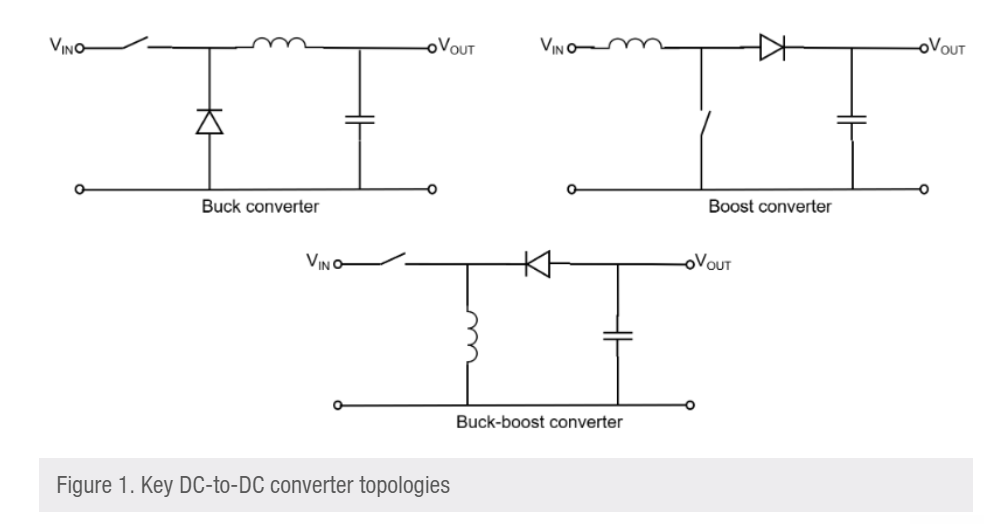
What Are the Benefits of Instantaneous Power Measurement of a DC-To-DC Converter Using a Dynamic DAQ?
The instantaneous power is the product of the instantaneous voltage v and current i. When you measure average power, the instantaneous power readings have to be integrated over a specified time to obtain the average power. So, what are the benefits of measuring the instantaneous power of a DC-to-DC converter?
Benefits
• Monitor the peak output power of the converter — Depending on the design topology of the DC-to-DC converter since some are non-isolating converters. The transformer-based converters have better isolation and stable output. Nevertheless, DC-to-DC converter outputs need to be well-regulated. Excess peak power can be detrimental to your application.
• Measure the output of the transient response deviation and recovery time — This process is typically a test to determine how well-regulated the output voltage of the DC-to-DC converter, especially when operating at maximum voltage. When the output load abruptly increases or decreases, a transient voltage can manifest.
Test process
1. Connect an electronic load to the output of the DC-to-DC converter.
2. Set the electronic output load to pulse from minimum to the maximum and then back to the minimum.
You can do all of the above while monitoring the instantaneous output voltage and current. Figure 2 shows a typical test result of the output transient response deviation and recovery time based on settling band specifications.
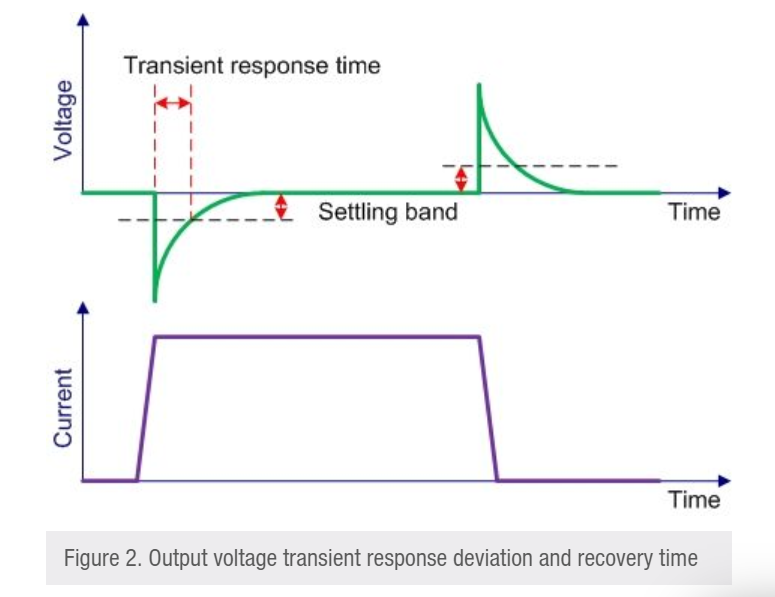
• Monitor instantaneous power efficiency — This test helps to characterize the converted power efficiency of your DC-to-DC converter over time. Various factors can influence the converter’s efficiency, such as output load conditions, temperature, humidity, and even component drifts.

where ɳ is the converted power efficiency
• Output voltage noise parameter – the DC-to-DC converters have transistors to switch the input voltage. The duty cycle of the switching will determine the output voltage level of the converters. The switching nature of the converter may result in residual output tone with harmonics at the converters output stage. There can be other noise factors that can contribute to the converters output stage. However, the output stage of the DC-to-DC converter must have an acceptable stable output voltage. The dynamic output voltage and current measurements are necessary to measure the noise parameter. Some data acquisition systems (DAQs) can perform a fast Fourier transform (FFT) to provide spectral output to quantify the nature of the noise parameter.
• Monitor operating temperature – using a DAQ system, you can easily create the synchronized temperature monitoring system of your DC-to-DC converter body while measuring the input power, output power, and power efficiency. This setup enables you to test the over-temperature protection circuit in your DC-to-DC converter.
How to Set Up the DAQ to Test the DC-to-DC converter
Hardware setup
Figure 3 shows a schematic block diagram for measuring the power efficiency of a DC-DC converter. Instruments used for this purpose include a DC power supply as the source, a DAQ with a 4-channel simultaneous sampling digitizer, and an electronic load. On a specific note, the DAQ’s 4-channel simultaneous sampling digitizer needs to have isolated differential channels to prevent noise affecting the measurements.
For power measurements, the current measurement uses a current shunt; R1 and R2 are current shunts. You can use a 0.001 Ohm current shunt, so the voltage drop at high current levels does not appreciably affect the input or output voltage of the converter.
You can measure the DC voltage (Ch 2) across the R1 current shunt and apply Ohm’s law to calculate the source current. Multiply the source current by the measured input voltage (Ch 1) to calculate the source power. Using the same process, you can calculate the load power. You will get the power efficiency of the DC-DC converter by calculating the ratio of the output power over the input power.

where ɳ is the converted power efficiency, Vout is the load output voltage, Iout is output current, Vin is the source input voltage, and Iin is source input current.
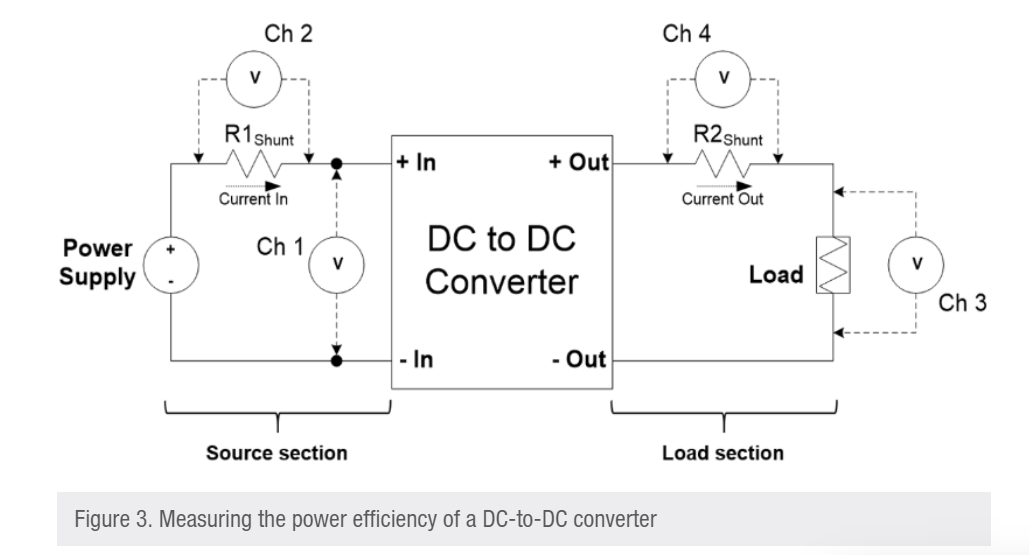
The voltages and currents are instantaneous measurements since we are using a 4-channel simultaneous sampling digitizer to measure Vout, Iout, Vin, and Iin. You can then immediately get the instantaneous power from the DAQ instrument.
To measure the output transient response deviation and recovery time, you have to create a current pulse train with your electronic load. This pulse train is simulating the output load for your DC-to-DC converter. You can then monitor simultaneously the current out from Ch 4 and the voltage output across the load from Ch 3.
Software setup
Using Keysight Pathwave BenchVue software in conjunction with Keysight’s DAQ970A and DAQ973A data acquisition systems enables you to remotely control your instruments with an intuitive point and click functionality. You can easily check the DC power supply, DAQ mainframe, and electronic load operations. The solution synchronously captures all your measurements for on-screen live graphical analysis, storage, and post-analysis work.
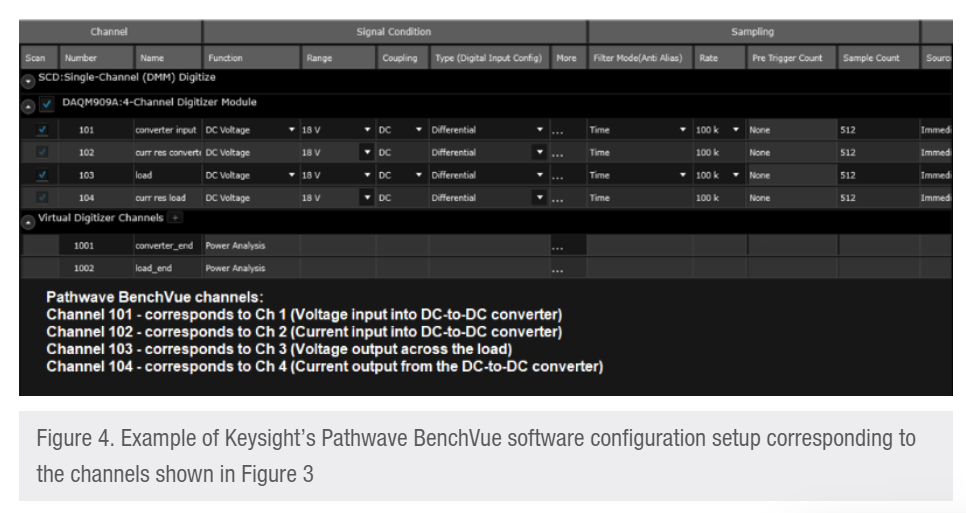
Figure 5 is an example of a virtual channel 1001 computations that occur in real-time. Channel 1 is multiplied to Channel 2 to obtain the power at source input of the DC-to-DC converter. Similarly, the calculation for virtual channel 1002 is in real time. You can multiply Channel 3 to Channel 4 to obtain the power at output load. If you want to, you can even create an extra channel 1003 to view the dynamic changes of the overall power efficiency by taking a ratio of channel 1002 over channel 1001.
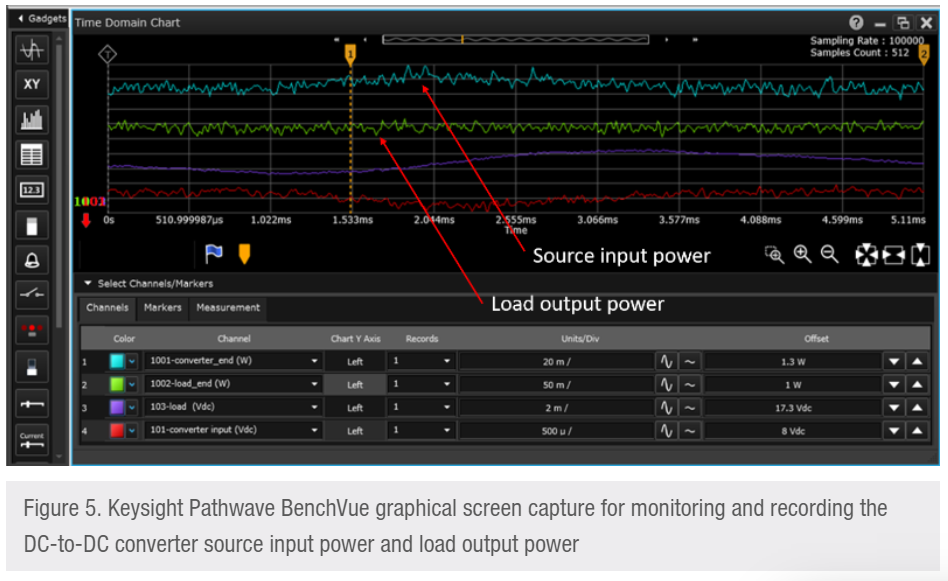
Summary
This blog is an introductory overview of the key DC-to-DC converter topologies. It covers the benefits of using a dynamic DAQ to measure the instantaneous power of the converter and demonstrates how to set up a DAQ to test the DC-to-DC converter.
The DAQ system is incredibly versatile because it measures not only electrical voltages and currents; it can also measure temperature, humidity, and other physical parameters. It can also connect DC power sources and electronic loads to your devices under test or converters. You can use it for R&D converter design validation tasks and is scalable by adding input modules for manufacturing test.
The DAQ970A/DAQ973A data acquisition mainframe and the DAQM909A 4-channel simultaneous sampling digitizer with isolated differential input channels were used for the power efficiency measurement.
For more information on Keysight’s data acquisition system, please visit www.keysight.com/find/DAQ.
Purchasing the Keysight’s DAQ970A/DAQ973A hardware includes the Keysight PathWave BenchVue DAQ software. You can check out the software here: Data Acquisition Control & Analysis.
To learn more about dynamic data acquisition, please click and download the Dynamic Data Acquisition Systemwhite paper.
《在此下載技術文章電子檔》
Monitoring Instantaneous Power of a DC-To-DC Converter Using a Dynamic DAQ
by Keysight Product Manager - Bernard Ang
Because of their conversion efficiency, DC-to-DC converters are commonly used in electrical and electronic systems. Within their working range, they accept a wide range of input voltages to give you an isolated stable output voltage.
DC-to-DC converters come with three main types of topologies:
• Buck converter that steps down the voltage from its input to its output.
• Boost converter that steps up the voltage from its input to its output.
• Buck-boost converter that allows the input voltage to be either stepped-up or stepped-down. The output voltage polarity of the buck-boost converter typically inverts from the input voltage.
There are additional complex types of topologies — this blog provides an overview of the three mentioned above. Figure 1 displays the three types of topologies just mentioned.

What Are the Benefits of Instantaneous Power Measurement of a DC-To-DC Converter Using a Dynamic DAQ?
The instantaneous power is the product of the instantaneous voltage v and current i. When you measure average power, the instantaneous power readings have to be integrated over a specified time to obtain the average power. So, what are the benefits of measuring the instantaneous power of a DC-to-DC converter?
Benefits
• Monitor the peak output power of the converter — Depending on the design topology of the DC-to-DC converter since some are non-isolating converters. The transformer-based converters have better isolation and stable output. Nevertheless, DC-to-DC converter outputs need to be well-regulated. Excess peak power can be detrimental to your application.
• Measure the output of the transient response deviation and recovery time — This process is typically a test to determine how well-regulated the output voltage of the DC-to-DC converter, especially when operating at maximum voltage. When the output load abruptly increases or decreases, a transient voltage can manifest.
Test process
1. Connect an electronic load to the output of the DC-to-DC converter.
2. Set the electronic output load to pulse from minimum to the maximum and then back to the minimum.
You can do all of the above while monitoring the instantaneous output voltage and current. Figure 2 shows a typical test result of the output transient response deviation and recovery time based on settling band specifications.

• Monitor instantaneous power efficiency — This test helps to characterize the converted power efficiency of your DC-to-DC converter over time. Various factors can influence the converter’s efficiency, such as output load conditions, temperature, humidity, and even component drifts.

where ɳ is the converted power efficiency
• Output voltage noise parameter – the DC-to-DC converters have transistors to switch the input voltage. The duty cycle of the switching will determine the output voltage level of the converters. The switching nature of the converter may result in residual output tone with harmonics at the converters output stage. There can be other noise factors that can contribute to the converters output stage. However, the output stage of the DC-to-DC converter must have an acceptable stable output voltage. The dynamic output voltage and current measurements are necessary to measure the noise parameter. Some data acquisition systems (DAQs) can perform a fast Fourier transform (FFT) to provide spectral output to quantify the nature of the noise parameter.
• Monitor operating temperature – using a DAQ system, you can easily create the synchronized temperature monitoring system of your DC-to-DC converter body while measuring the input power, output power, and power efficiency. This setup enables you to test the over-temperature protection circuit in your DC-to-DC converter.
How to Set Up the DAQ to Test the DC-to-DC converter
Hardware setup
Figure 3 shows a schematic block diagram for measuring the power efficiency of a DC-DC converter. Instruments used for this purpose include a DC power supply as the source, a DAQ with a 4-channel simultaneous sampling digitizer, and an electronic load. On a specific note, the DAQ’s 4-channel simultaneous sampling digitizer needs to have isolated differential channels to prevent noise affecting the measurements.
For power measurements, the current measurement uses a current shunt; R1 and R2 are current shunts. You can use a 0.001 Ohm current shunt, so the voltage drop at high current levels does not appreciably affect the input or output voltage of the converter.
You can measure the DC voltage (Ch 2) across the R1 current shunt and apply Ohm’s law to calculate the source current. Multiply the source current by the measured input voltage (Ch 1) to calculate the source power. Using the same process, you can calculate the load power. You will get the power efficiency of the DC-DC converter by calculating the ratio of the output power over the input power.

where ɳ is the converted power efficiency, Vout is the load output voltage, Iout is output current, Vin is the source input voltage, and Iin is source input current.

The voltages and currents are instantaneous measurements since we are using a 4-channel simultaneous sampling digitizer to measure Vout, Iout, Vin, and Iin. You can then immediately get the instantaneous power from the DAQ instrument.
To measure the output transient response deviation and recovery time, you have to create a current pulse train with your electronic load. This pulse train is simulating the output load for your DC-to-DC converter. You can then monitor simultaneously the current out from Ch 4 and the voltage output across the load from Ch 3.
Software setup
Using Keysight Pathwave BenchVue software in conjunction with Keysight’s DAQ970A and DAQ973A data acquisition systems enables you to remotely control your instruments with an intuitive point and click functionality. You can easily check the DC power supply, DAQ mainframe, and electronic load operations. The solution synchronously captures all your measurements for on-screen live graphical analysis, storage, and post-analysis work.

Figure 5 is an example of a virtual channel 1001 computations that occur in real-time. Channel 1 is multiplied to Channel 2 to obtain the power at source input of the DC-to-DC converter. Similarly, the calculation for virtual channel 1002 is in real time. You can multiply Channel 3 to Channel 4 to obtain the power at output load. If you want to, you can even create an extra channel 1003 to view the dynamic changes of the overall power efficiency by taking a ratio of channel 1002 over channel 1001.

Summary
This blog is an introductory overview of the key DC-to-DC converter topologies. It covers the benefits of using a dynamic DAQ to measure the instantaneous power of the converter and demonstrates how to set up a DAQ to test the DC-to-DC converter.
The DAQ system is incredibly versatile because it measures not only electrical voltages and currents; it can also measure temperature, humidity, and other physical parameters. It can also connect DC power sources and electronic loads to your devices under test or converters. You can use it for R&D converter design validation tasks and is scalable by adding input modules for manufacturing test.
The DAQ970A/DAQ973A data acquisition mainframe and the DAQM909A 4-channel simultaneous sampling digitizer with isolated differential input channels were used for the power efficiency measurement.
For more information on Keysight’s data acquisition system, please visit www.keysight.com/find/DAQ.
Purchasing the Keysight’s DAQ970A/DAQ973A hardware includes the Keysight PathWave BenchVue DAQ software. You can check out the software here: Data Acquisition Control & Analysis.
To learn more about dynamic data acquisition, please click and download the Dynamic Data Acquisition Systemwhite paper.
